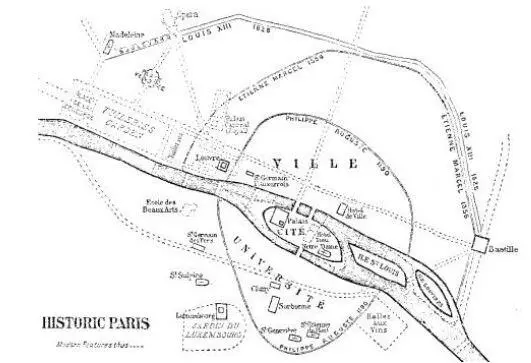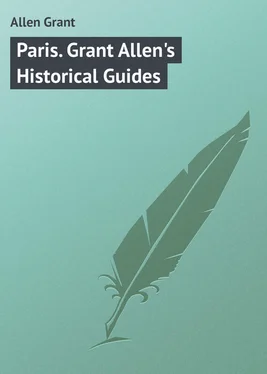Grant Allen - Paris. Grant Allen's Historical Guides
Здесь есть возможность читать онлайн «Grant Allen - Paris. Grant Allen's Historical Guides» — ознакомительный отрывок электронной книги совершенно бесплатно, а после прочтения отрывка купить полную версию. В некоторых случаях можно слушать аудио, скачать через торрент в формате fb2 и присутствует краткое содержание. ISBN: , Издательство: Иностранный паблик, Жанр: foreign_language, foreign_prose, на английском языке. Описание произведения, (предисловие) а так же отзывы посетителей доступны на портале библиотеки ЛибКат.
- Название:Paris. Grant Allen's Historical Guides
- Автор:
- Издательство:Иностранный паблик
- Жанр:
- Год:неизвестен
- ISBN:http://www.gutenberg.org/ebooks/49907
- Рейтинг книги:4 / 5. Голосов: 1
-
Избранное:Добавить в избранное
- Отзывы:
-
Ваша оценка:
- 80
- 1
- 2
- 3
- 4
- 5
Paris. Grant Allen's Historical Guides: краткое содержание, описание и аннотация
Предлагаем к чтению аннотацию, описание, краткое содержание или предисловие (зависит от того, что написал сам автор книги «Paris. Grant Allen's Historical Guides»). Если вы не нашли необходимую информацию о книге — напишите в комментариях, мы постараемся отыскать её.
Paris. Grant Allen's Historical Guides — читать онлайн ознакомительный отрывок
Ниже представлен текст книги, разбитый по страницам. Система сохранения места последней прочитанной страницы, позволяет с удобством читать онлайн бесплатно книгу «Paris. Grant Allen's Historical Guides», без необходимости каждый раз заново искать на чём Вы остановились. Поставьте закладку, и сможете в любой момент перейти на страницу, на которой закончили чтение.
Интервал:
Закладка:
To visit the interior, enter by the L, or northern door of the façade – that of Our Lady. The lofty nave is flanked by double aisles, all supported by powerful piers. Walk across the church and notice all five vistas. Observe the height and the delicate arches of the triforium, or pierced gallery of the second story, as well as the windows of the clerestory above it – the part of the nave which rises higher than the aisles, and opens freely to the exterior. Walk down the outer R aisle. The side-chapels, each dedicated to a separate saint, contain the altars and statues of their patrons. Notice the shortness of the Transepts, with their great rose windows; observe also the vaulting of the roof, especially at the intersection of the four main arms of the building. The entrance to the choirand ambulatoryis in the R or S Transept. Close by, near the pillar, Notre-Dame de Paris, the wonder-working mediæval statue of Our Lady. The double aisles are continued round the choir, which is separated from them by a wall and gateways. Approach the brass grills, in order to inspect the interior of the choir, whose furniture was largely modernised and ruined by Louis XIV, in accordance with a misguided vow of his father. Chapels surround the ambulatory, many of them with good glass windows and tolerable frescoes. The chapel at the end is that of Our Lady of the Seven Sorrows.
By far the most interesting object in the interior, however, is the series of **high reliefs in stone, gilt and painted (on the wall between choir and ambulatory), executed early in the 14th century by Jehan Ravy and his nephew, Jehan de Bouteillier, which, though inferior in merit to those in the same position in Amiens cathedral, are admirable examples of animated and vigorous French sculpture of their period. The series begins on the N side of the choir, at the point most remote from the grill which leads to the Transept. The remaining subjects (for some, like the Annunciation, are destroyed) comprise the Visitation; Adoration of the Shepherds; Nativity; Adoration of the Magi (note the Three Kings, representing the three ages of man; the oldest, as usual, has removed his crown, and is offering his gift); the Massacre of the Innocents; the Flight into Egypt (where a grotesque little temple, containing two odd small gods, quaintly represents the prevalence of idolatry); the Presentation in the Temple; Christ among the Doctors; the Baptism in Jordan (with attendant angel holding a towel); the Miracle at Cana; the Entry into Jerusalem (with Zacchæus in the tree, and the gate of the city); the Last Supper; the Washing of the Apostles’ feet; and the Agony in the Garden. The tourist should carefully examine all these subjects, the treatment of which strikes a keynote. Similar scenes, almost identical in their figures, will be found in abundance at Cluny and elsewhere. Note, for example, the symbolical Jordan in the Baptism, with St. John pouring water from a cup, and the attendant angel, all of which we shall often recognise hereafter.
The series is continued on the other (S) side of the choir (a little later in date, with names in Latin underneath; better modelled, but neither so quaint nor so vigorous). The subjects begin by the grill of the South Transept, with the “Noli me tangere” or Apparition to Mary Magdalen (Christ as a gardener); the Apparition to the Marys; to Simon Peter; to the Disciples at Emmaus (dressed as mediæval pilgrims); to the Eleven Apostles; to the Ten and Thomas; to the Eleven by the sea of Tiberias; to the Disciples in Galilee; and on the Mount of Olives. The intervening and remaining subjects – Scourging, Crucifixion, Ascension, etc. – were ruthlessly destroyed by Louis XIV, in order to carry out his supposed improvements in accordance with the vow of his father, Louis XIII. The woodwork of the choir-stalls, executed by his order, is celebrated, and uninteresting. You may omit it. The Treasury contains little of artistic value. The Crown of Thorns still figures in its inventory.
Leave the Choir by the door by which you entered it, and seat yourself for a while at the intersection of the Nave and Transepts, in order to gain a good idea of the Apse, the Choir, and the general arrangement of the shortly cruciform building. Observe the beautiful vaulting of the roof, and the extent to which the church is born on its piers alone, the intervening walls (pierced by windows and triforium-arches) being intended merely for purposes of enclosure. Note also the fine ancient glass of the rose windows. Quit the church by the North or Left Aisle, and come back to it often.
Those who are not afraid of a spiral staircase, mostly well lighted, should ascendthe Left or North Tower(tickets fifty cents. each, at the base of the tower). Stop near the top to inspect the gallery, with the famous birds and demons. The view hence embraces from the front the Tower of St. Jacques; behind it, the hill of Montmartre, with the white turrets and cupolas of the church of the Sacré-Cœur; a little to the L, St. Eustache; then the Tribunal de Commerce; St. Augustin; the Louvre; the roof of the Ste. Chapelle; the Arc de Triomphe; the twin towers of the Trocadéro; the Eiffel Tower; the gilded dome of the Invalides; St. Sulpice, etc. The Île de la Cité is well seen hence as an island. Note also the gigantic size of the open screen, which looked so small from below. Ascend to the top. Good general panorama of the town and valley. This is the best total view of Paris, far superior to that from the Eiffel Tower, being so much more central.
Return by the Pont d’Arcole (whence you get a capital notion of the bifurcation of the Seine around the Île St. Louis), and then pass the modern Hôtel-de-Ville, with St. Gervais behind it, on your way home to the Rue de Rivoli.

[Map of] HISTORIC PARIS
This Map represents approximately the growth of Paris, outside the island, at different epochs. Earlier buildings are printed in black; later streets and edifices are shown by means of dotted lines. But the Map does not represent the aspect of Paris at any one time; it merely illustrates this Guide: thus, the original Château of the Louvre is marked in black; the later Palace is dotted; whereas the Madeleine, a much more modern building than the Louvre of François I, is again inserted in black, because it does not interfere with the site of any more ancient building. In very early times the town spread south as far only as Cluny, and north (just opposite the island) as far as the Rue de Rivoli. The subsequent walls are marked approximately on the Map, with the chief edifices enclosed by them. The fortifications of Louis XIII were demolished by Louis XIV, who substituted for them the broad streets still known as the Boulevards. This Map shows, roughly speaking, the extent of Paris under Louis XIV; by comparing it with Baedeker’s Map of Modern Paris, the small relative size of the 17th-century town will be at once appreciated. Nevertheless, the inner nucleus here mapped out contains almost everything worthy of note in the existing city.
II
THE LEFT OR SOUTH BANK
[THE earliest overflowof Paris was from the Île de la Cité to the Leftor South Bank( Rive Gauche ).
The reason for this overflow is clear. The city was situated on a small island, near the head of navigation; it guarded the passage of the Seine by the double bridge. Naturally, however, at a time when all civilization lay to the south, as the town began to grow, it spread southward, towards Rome, Lyons, Marseilles, Bordeaux, Toulouse, Arles, Nîmes, and the Roman culture. To the north at that time lay nothing but comparative barbarism – the Britons and the Germans; or later, the English, the Normans, and the Teutonic hordes. Hence, from a very early date, Paris first ran southwardalong the road to Rome. Already in Roman times, here stood the palace of Constantius Chlorus and Julian, now the Thermes – the fortress which formed the tête du pont for the city. Later, the southern suburb became the seat of learning and law; it was known by the name which it still in part retains of the Université, but is oftener now called the Quartier Latin . At first, however, only a small portion of the Left Bank was built over. But gradually the area of the new town spread from the immediate neighbourhood of the old Hôtel-Dieu, with its church or chapel of St. Julien-le-Pauvre, to the modern limit of the Boulevard St. Germain; and thence again, by the time of Louis Quatorze, to the further Boulevards just south of the Luxembourg. It is interesting to note, too, that all this southern side, long known as the Université, still retains its position as the learned district. Not only does it include the students’ region – the Quartier Latin – with many of the chief artistic studios, but it embraces in particular the Sorbonne, or University, the Institute of France, with its various branches (Académie Française, Académie des Inscriptions et Belles-Lettres, Académie des Sciences, des Beaux-Arts, etc.), the École des Beaux-Arts, the École de Médicine, the Collège de France, the Lycées St. Louis, Louis-le-Grand, and Henri IV, the École Polytechnique, the École des Mines, the Bibliothèque Ste. Geneviève, the Jardin des Plantes, and the Luxembourg Museum of Modern Paintings. In short, the Left Bank represents literary, scientific, artistic, and educational Paris – the students in law, arts, and medicine, with their own subventioned theatre, the Odéon, and their libraries, schools, laboratories, and cafés . It is further noticeable that these institutions cluster thickest round the older part of the southern suburb, just opposite the Cité, while almost all of them lie within the limits of the outer boulevards of Louis XIV.
Читать дальшеИнтервал:
Закладка:
Похожие книги на «Paris. Grant Allen's Historical Guides»
Представляем Вашему вниманию похожие книги на «Paris. Grant Allen's Historical Guides» списком для выбора. Мы отобрали схожую по названию и смыслу литературу в надежде предоставить читателям больше вариантов отыскать новые, интересные, ещё непрочитанные произведения.
Обсуждение, отзывы о книге «Paris. Grant Allen's Historical Guides» и просто собственные мнения читателей. Оставьте ваши комментарии, напишите, что Вы думаете о произведении, его смысле или главных героях. Укажите что конкретно понравилось, а что нет, и почему Вы так считаете.












